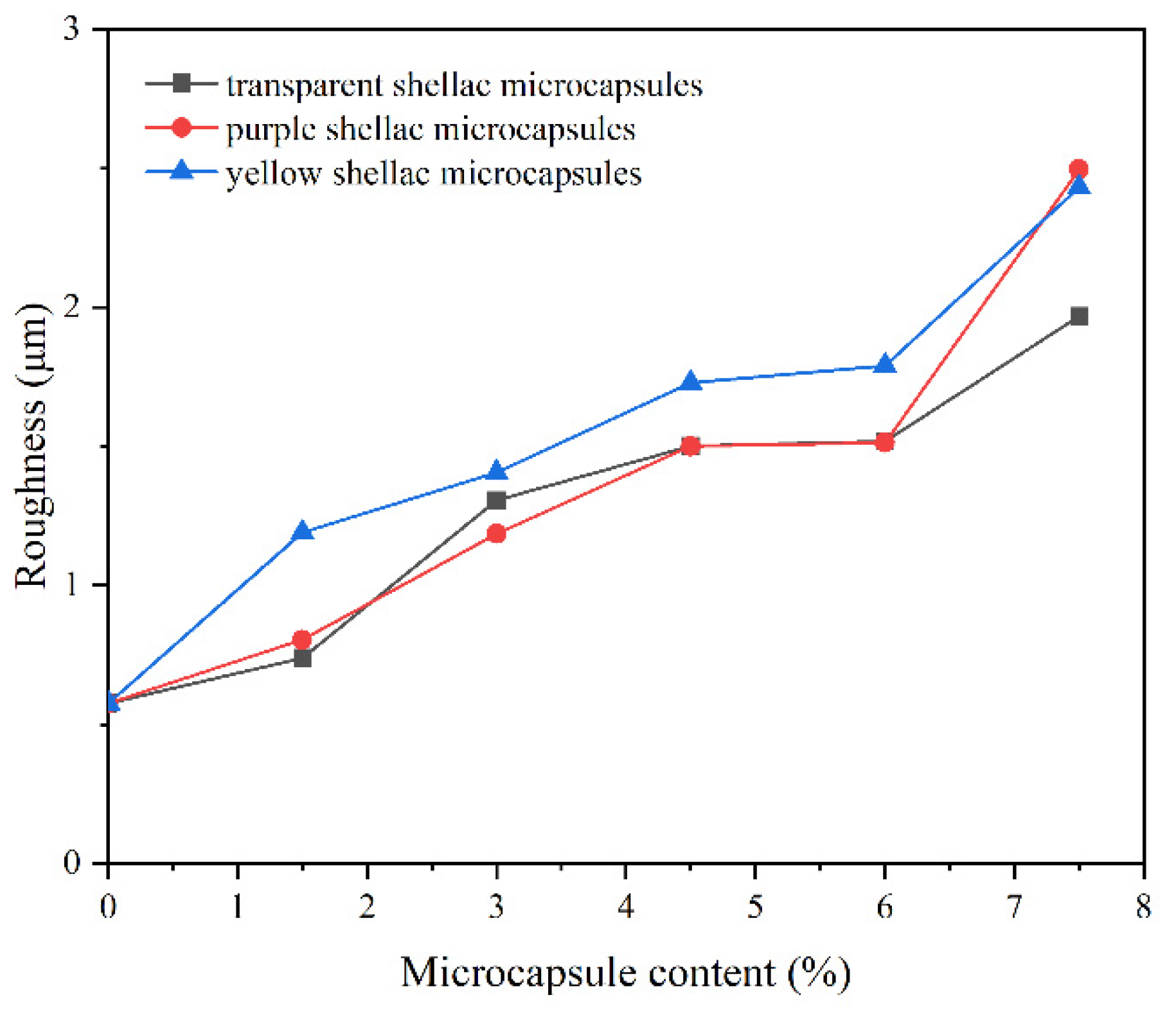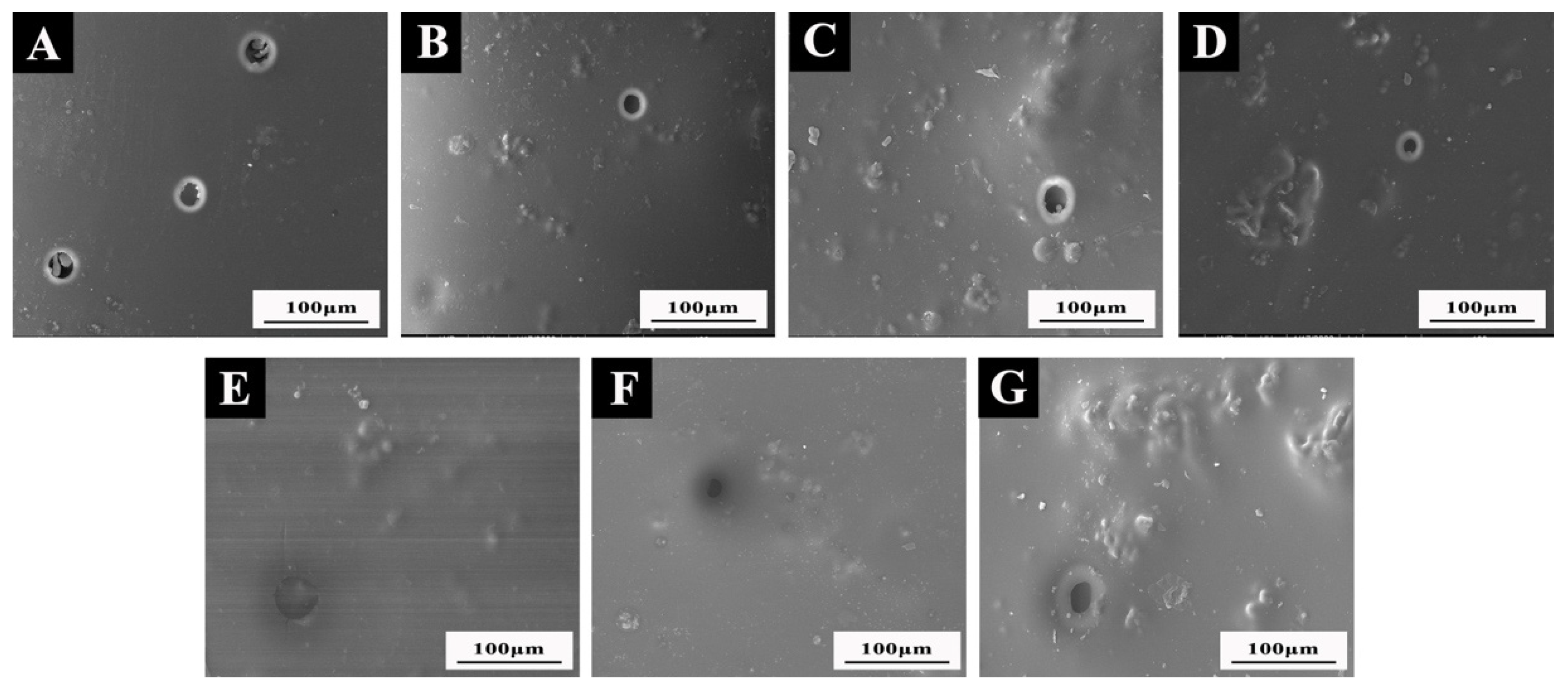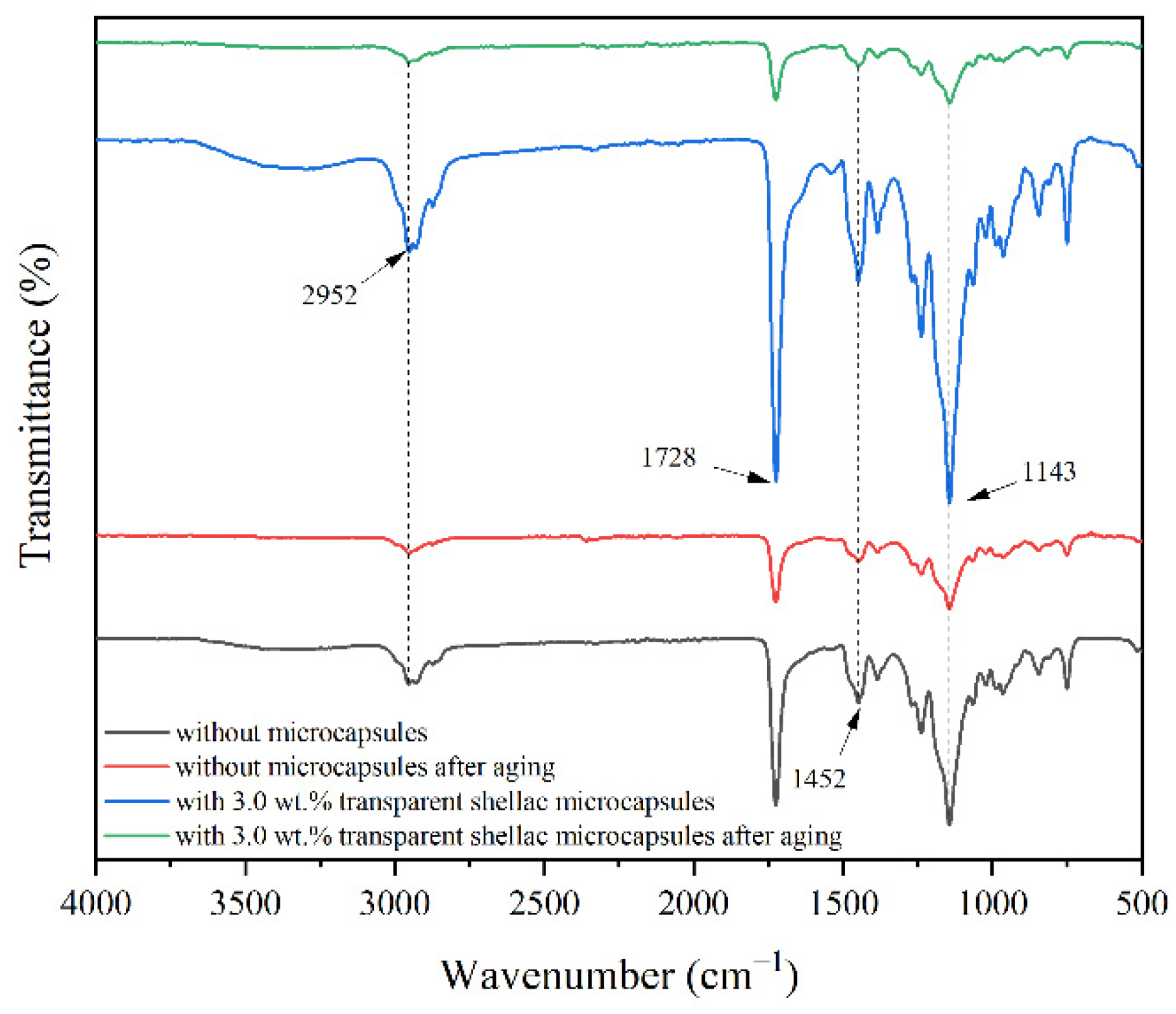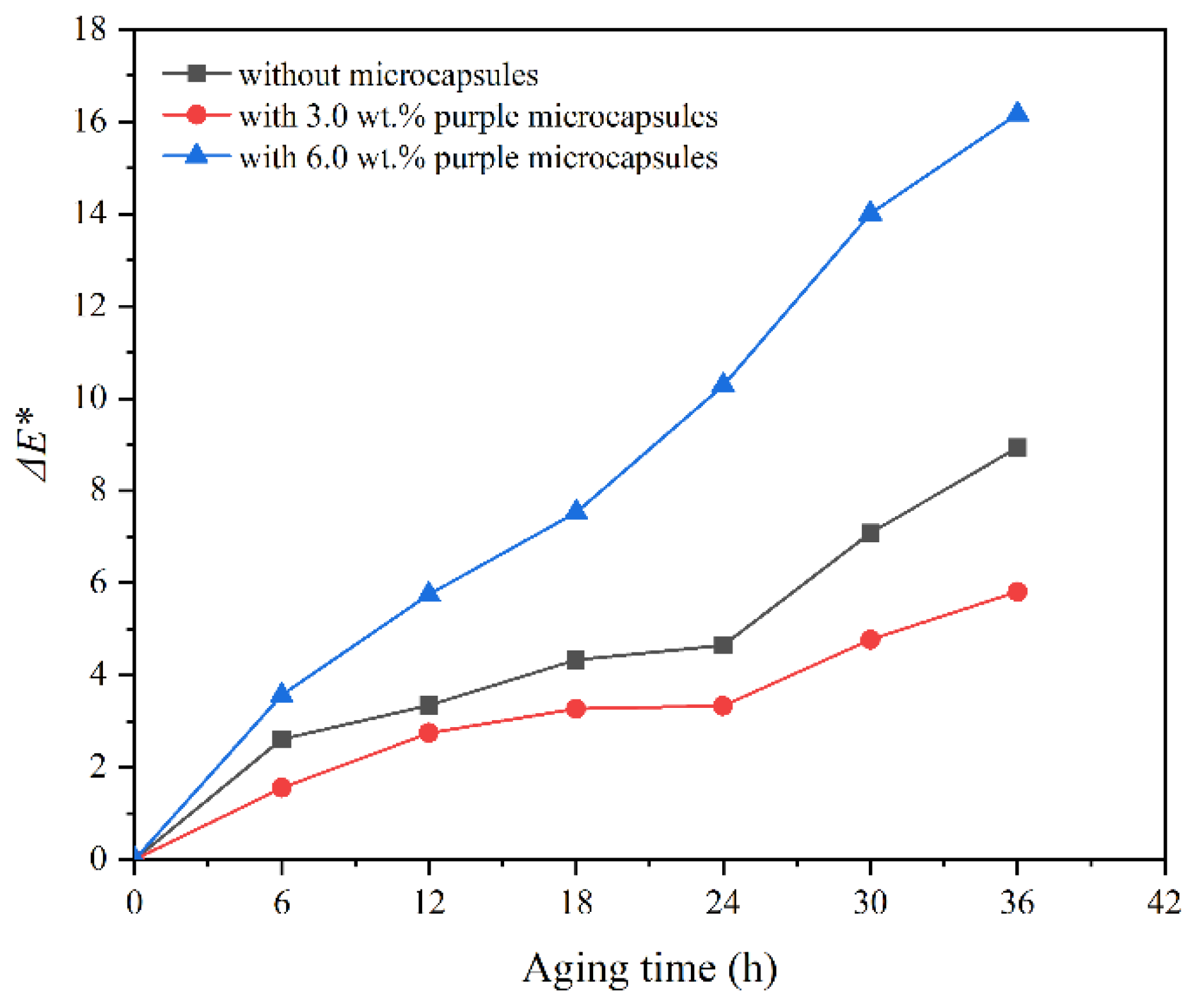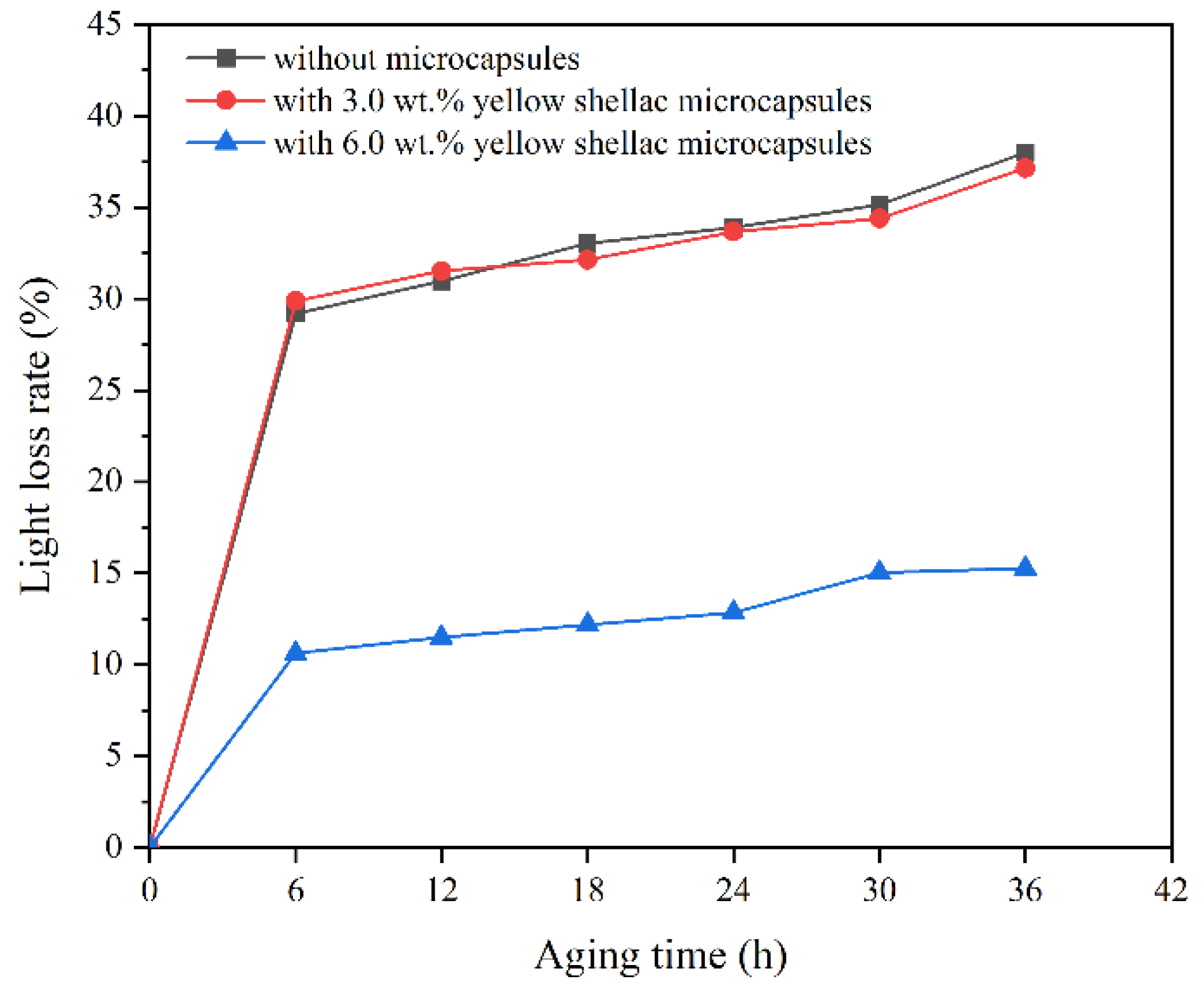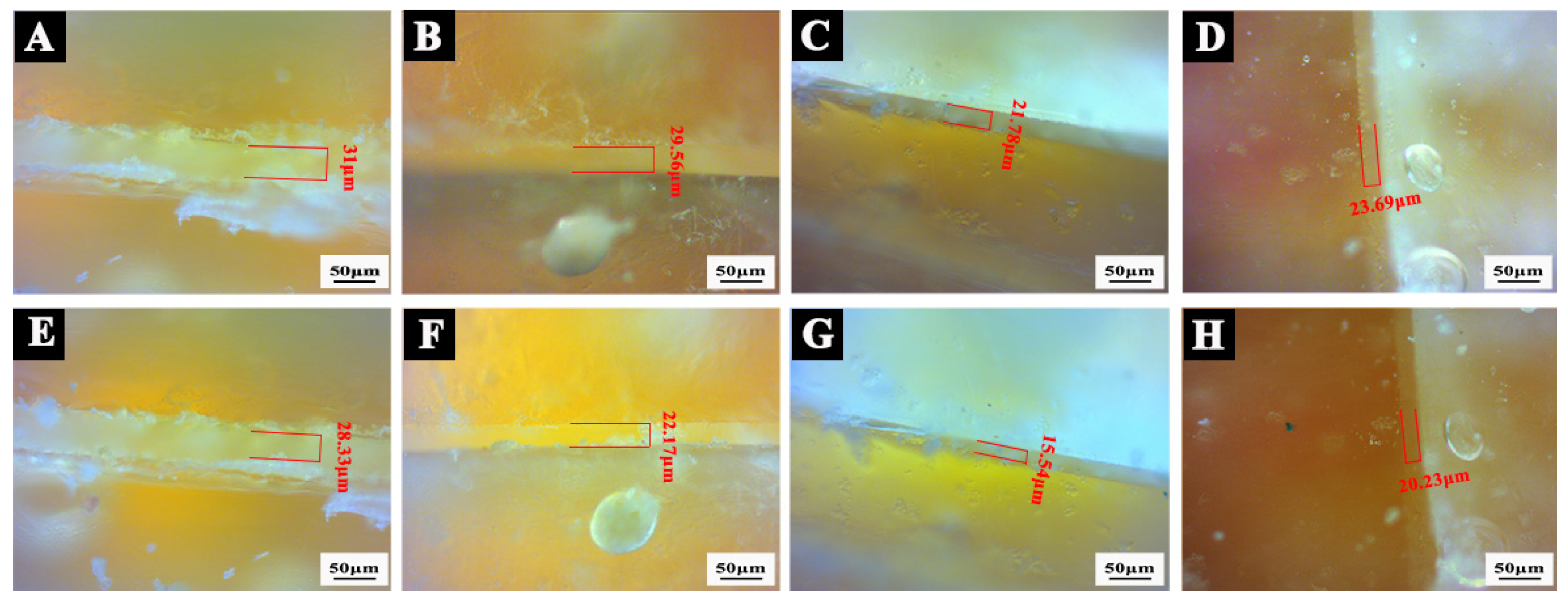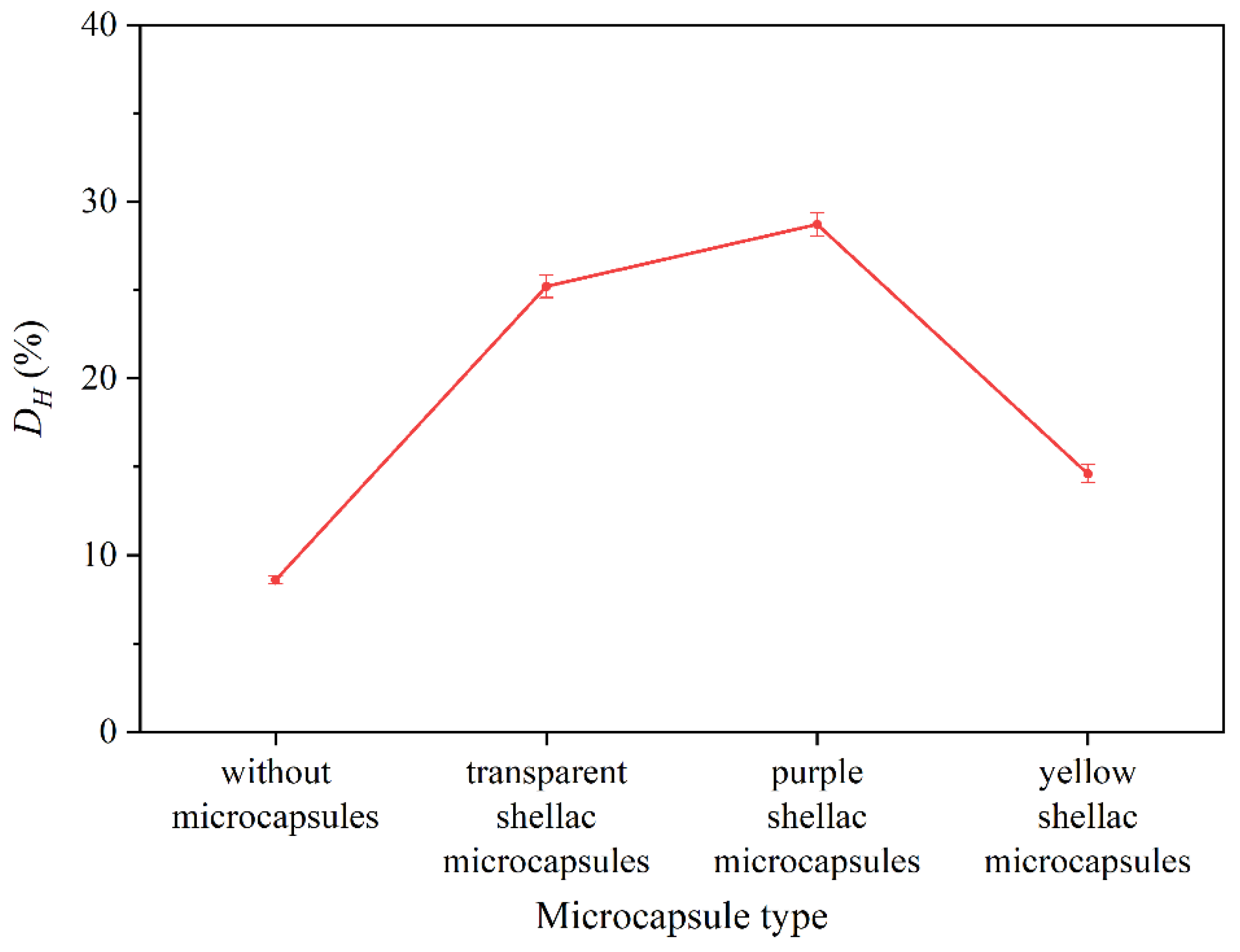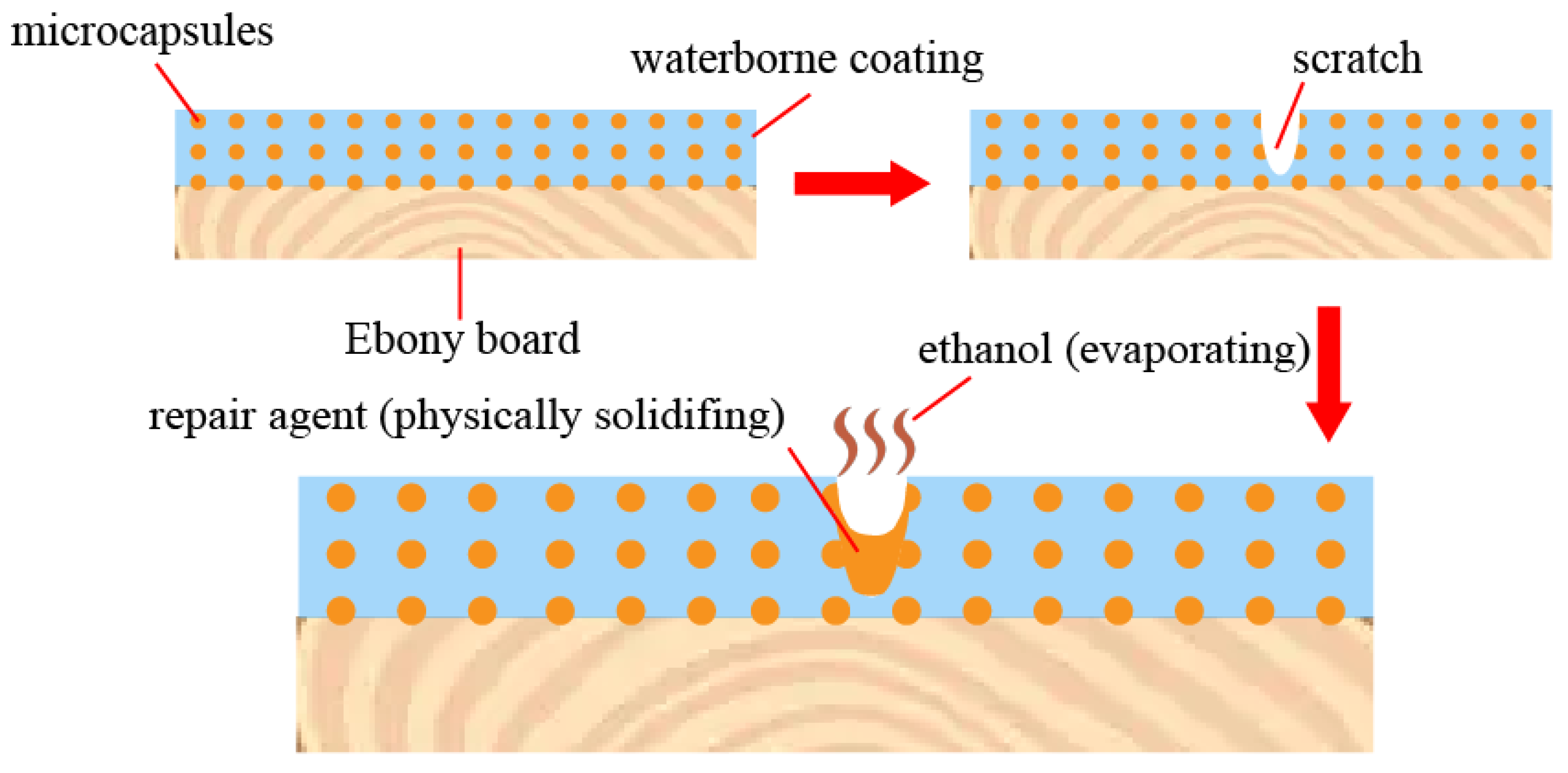1. Introduction
Wood has beautiful patterns [
1,
2,
3,
4,
5], superior mechanical characteristics [
6,
7,
8], and is environmentally beneficial [
9,
10]. It is frequently utilized as the main source of everyday goods such as furniture [
11,
12], architecture [
13], and musical instruments [
14]. The stability and durability of wood are, however, easily impacted by the external environment because it is a porous natural heterogeneous polymer composite [
15]. To protect the substrate, the wood is frequently coated after machining [
16,
17]. However, due to external forces or the dry shrinkage and wet expansion characteristics of wood [
18], the film is susceptible to microcracks. Without human treatment, the microcrack would worsen and become larger, losing the wood surface coating’s protective properties and resulting in unexpected economic losses.
Microcapsule technology is a type of packaging technology that coats gases, liquids, or solids in the form of microscopic particles using natural or synthetic polymer film-forming chemicals [
19]. Although there is not a generally applicable coating method for all core materials [
20], the microcapsules are still widely used in the fields of medicine [
21], food [
22], fabrics [
23], coatings [
24], and more [
25] because of the advantages of their structure in completely insulating the core material from the outside environment to preserve the core material’s original performance. With the aid of microcapsules and self-healing technology [
26], the self-healing microcapsules are embedded into waterborne coatings that are painted on the surface of the wood in order to effectively inhibit and repair microcracks of waterborne coating and protect the wood board [
27]. Xu et al. [
28] used phase change materials to load multi-compartment microcapsules synthesized through Pickering emulsion polymerization by encapsulating hydrophobic materials with titanium dioxide nanocapsules. Thermal insulation, antireflection, and self-healing abilities of the coating with microcapsules were all strengths. After adding a polyurea formaldehyde (PU) microcapsule containing cerium nitrate to an epoxy resin coating, Farzi et al. [
29] discovered that the epoxy coating would successfully self-repair once it was damaged because the coated cerium nitrate would be released from the microcapsules. To create PU/PANI double-shell microcapsules that are loaded with tung oil, Feng et al. [
30] first created tung oil microcapsules enclosed by PU by interfacial polymerization. Then, they deposited polyaniline (PANI) on the surface of the PU microcapsules in situ. It was established that the tung oil core and PANI shell of the microcapsules contributed to the coating’s remarkable self-healing and anti-corrosion capabilities by adding 10 wt.% double-shell microcapsules to the epoxy resin coating. Wu et al. [
31] used a one-pot photopolymerization and interfacial aniline polymerization to synthesize the robust PANI microcapsules, which were uniformly dispersed in the waterborne epoxy coating to provide it the self-repairing and anti-corrosion capabilities.
Urea-formaldehyde (UF) resin and melamine-formaldehyde (MF) are widely used as wall materials for preparing microcapsules by in situ polymerization, where the microcapsule walls are formed from the outside of micro core materials (small solid particles or droplets). Compared with UF, MF has superior adhesion, better moisture resistance, and lower formaldehyde emission [
32]. The shellac microcapsules encapsulated by MF resin has good self-healing abilities in a waterborne acrylic resin coating [
33,
34]. Since the 18th century, Beli wood (
Paraberlinia bifoliolata) has been prized as expensive sawn wood. It benefits from having a high density, good strength, strong resistance to corrosion, and beautiful patterns [
35]. It is frequently utilized to create building materials, fine furniture, flooring, and carvings. Under the effect of environmental moisture, it is simple to deform or crack, which results in economic losses. The dimensional instability of wood destroys the coating and causes it to lose its protective role. Therefore, it is crucial to investigate self-healing coatings combined with microcapsule technology in order to retain the stability and usefulness of the coating on wood.
Existing research demonstrates that the shellac microcapsule content has a considerable impact on the physical, chemical, and repair properties of waterborne films [
36]. The waterborne film had better all-around qualities when the microcapsule content is less than 6.0 wt.% [
37]. The main shellac resin products available on the market are transparent shellac, purple shellac, and yellow shellac. These products vary depending on the various raw materials’ geographic origins and treatment techniques [
38]. All the active substances have the same chemical ingredient [
39]. However, it has not been made obvious how shellac resin compounds with different colors affect the mechanical, self-repairing, and optical characteristics of waterborne coatings.
Therefore, in this paper, various types of shellac microcapsules (transparent shellac, purple shellac, and yellow shellac) were mixed with the waterborne coating at the contents of 0, 1.5 wt.%, 3.0 wt.%, 4.5 wt.%, 6.0 wt.%, and 7.5 wt.%, and then coated on the surface of Beli wood to investigate the applicability of self-repairing coating of embedded microcapsules on the wood board.
By characterizing and analyzing the optical, mechanical, physical, and chemical properties, aging resistance, and scratch repair performance of prepared waterborne coatings, the types of shellac microcapsules that were most suitable for the self-healing coating on the surface of Beli wood and the optimal content of these microcapsules in the coating were determined. Self-repairing mechanism analysis of the waterborne coating with shellac microcapsules based on the Beli wood surface was illustrated, which contributes to the optimization of shellac microcapsules and the development of self-healing waterborne coatings on the surface of wooden constructions and products.
2. Materials and Methods
2.1. Test Materials
Both the 37 wt.% formaldehyde solution and ethyl acetate were bought from Xi’an Tianmao Chemical Co., Ltd., Xi’an, China. The emulsifiers Span-20 (sorbitan monolaurate), Tween-20 (polyoxyethylene sorbitan monolaurate), and melamine were bought from Shandong Yousuo Chemical Technology Co., Ltd., Linyi, China. The triethanolamine was purchased from Guangzhou Jiale Chemical Co., Ltd., Guangzhou, China. Rosin was bought from Suzhou Guyue Musical Instrument Co., Ltd., Suzhou, China. Citric acid monohydrate was acquired from Nanjing Quanlong biological hydration Technology Co., Ltd., Nanjing, China. Absolute ethanol was acquired from Wuxi Jingke Chemical Co., Ltd., Wuxi, China. The waterborne coating was purchased from Dulux Coatings Co., Ltd. Shanghai, China. Water, a matting agent, an additive, and waterborne acrylic acid copolymer dispersion were the main components. Transparent shellac, purple shellac, and yellow shellac were among the varieties of 12.5 wt.% pure shellac that were obtained from Shanghai Yuyan Building Materials Co., Ltd., Shanghai, China.
2.2. Preparation Method of Microcapsules
Take the microcapsules containing transparent shellac in the core material as an example.
- (1)
Prepolymerization of the wall material
The 3.5:1 molar ratio of 12.00 g melamine to 27.04 g 37 wt.% formaldehyde solution was combined into a beaker. Then, 60 mL of distilled water was added. The hydroxymethyl melamine mixture was synthesized by constantly stirring the mixture at 600 rpm for 30 min in a 70 °C DF-101s constant temperature water bath (Gongyi Yuhua Instrument Co., Ltd., Zhengzhou, China) after several drops of triethanolamine were applied to adjust the pH of the mixture to 8–9.
- (2)
Synthesis of the core material
For standby, 8.8 g of each liquid (shellac and rosin) was weighed and equally combined. The beaker was filled with 157.8 mL of absolute ethanol, 0.3 g of Span-20, and 0.3 g of Tween-20. Then, the shellac–rosin mixture was added to the mixture. After thoroughly stirring, the prepared liquid was stirred for 60 min at a speed of 600 rpm in a water bath with a constant temperature of 60 °C to create the core material.
- (3)
In situ polymerization of microcapsules
Using a stirrer at 600 rpm, the core material emulsion was gradually added to the MF prepolymer solution. The mixture was placed in the BILON-500 ultrasonic material emulsion disperser (Shanghai Bilang Instrument Co., Ltd., Shanghai, China) for 15 min. Following ultrasonic blending, the solution was put into a water bath pot, and the pH of the solution was adjusted with citric acid at a 600 rpm speed. The temperature was gradually raised to 60 °C for a constant temperature reaction for 3 h after the pH level reached approximately 4.5. After 3 d, the resulting mixture was filtered, thoroughly cleaned with deionized water and ethanol using the SHZ-D circulating water multipurpose vacuum pump (Henan Yuhua Instrument Co., Ltd., Zhengzhou, China), and then dried.
The parallel method and amount of shellac solution were used to make microcapsules with purple and yellow shellac.
2.3. Preparation Method for Films
Beli (Paraberlinia bifoliolate) wood boards (50 mm × 50 mm × 10 mm; length × width × thickness, respectively) were supplied by Beijing Tiantan Furniture Co., Ltd., Beijing, China. The surface of Beli wood boards was sanded along the wood grain direction with 300 mesh (48 μm) sandpaper. Then, a 600 mesh (23 μm) sandpaper was used to fine sand the wood boards in the same way. The sawdust produced by sanding was cleaned with a brush and wiped with a dry cloth for standby.
At the contents of 0, 1.5 wt.%, 3.0 wt.%, 4.5 wt.%, 6.0 wt.%, and 7.5 wt.%, the transparent, purple, and yellow shellac microcapsules were embedded into the waterborne coatings, stirred, and mixed evenly to obtain the self-healing coating (every sample at 4.00 g). The coatings were uniformly applied to the Beli wood board surface using a brush. The samples were dried for 3 h in a cool, well-ventilated environment, and the waterborne film’s surface was sanded using fine sandpaper with a mesh size of 600. The coated boards were placed for 12 h in preparation for further testing after the similar methods were repeated twice.
2.4. Testing and Characterization
The gloss was measured using an HG268 gloss meter (Shenzhen Threenh Technology Co., Ltd., Shenzhen, China) in accordance with the Chinese standard GB/T 4893.6-2013 for coatings based on the surface of Beli wood boards [
40]. A SEGT-J portable chromatic difference instrument (Zhuhai Tianchuang Instrument Co., Ltd., Zhuhai, China) was employed to examine the coating’s chromaticity value based on the Beli wood surface before and after aging in accordance with Chinese standard GB/T 11186.3-1989. The chromaticity values of the waterborne film without microcapsules were recorded as
L1,
a1, and
b1. The chromaticity values of the waterborne film with microcapsules were recorded as
L2,
a2, and
b2. The Δ
E* (chromatic difference) of the waterborne film was determined by averaging the four points from each film. Δ
L* indicates lightness difference, Δ
a* indicates the difference between red and green, and Δ
b* indicates the difference between yellow and blue. The CIELAB chromatic difference Formula (1) was used to determine the chromatic difference of waterborne coatings containing shellac microcapsules [
41,
42].
A pencil hardness tester was employed to examine the hardness of waterborne film using 6H–6B pencils in accordance with GB/T 6739-2006 [
43]. The 6B is the softest, 6H is the hardest, and HB is the middle value. The highest hardness of the pencil was noted as the coating’s hardness before an indentation occurred on the coating’s surface. To evaluate the adhesion grade of the coating, QFH-HG600 film scribing equipment (Shanghai Le’ao Test Instrument Co., Ltd., Shanghai, China) was utilized. There are six grades, of which grade 0 denotes the best adhesion of the coating and grade 5 denotes the worst adhesion of the coating. According to GB/T 1731-1993 [
44], the impact resistance of the coating is characterized by a QCJ film impactor tester (Shanghai Le’ao Test Instrument Co., Ltd., Shanghai, China). The JB-4C precise roughness tester (Shanghai Taiming Optical Instrument Co., Ltd., Shanghai, China) was employed to assess the coating’s roughness.
According to GB/T 4893.1-2021 [
45], the test solutions for the cold liquid resistance test of coating based on Beli wood surface were soy sauce, iodine, toilet water, and 75% medical ethanol. The coated surface was first cleaned. The test solution was applied to the filter paper. It was removed, and then it was applied to the coating surface in a closed environment. The filter paper was removed after a while, and any remaining liquid on the surface was cleaned. After standing for 18 h, the damage to the coating surface was observed, and the grade was evaluated concerning the grading table (
Table 1). By using a chromatic difference meter to record the chromaticity value of the Beli wood surface coating before and after the liquid resistance test, the Δ
E* was calculated according to Formula (1).
The chemical composition of microcapsules, wall material, core material, and the waterborne coating on the surface of Beli wood was examined using the VERTEX 80V Fourier transform infrared spectrometer (FTIR, Shanghai Smio Analytical Instrument Co., Ltd., Shanghai, China). The Quanta-200 scanning electron microscope (SEM, FEI Company, Hillsboro, OR, USA) was chosen to characterize the micromorphology of shellac microcapsules encapsulated by MF resin and waterborne coatings on the Beli wood surface. The particle size distribution of microcapsules was measured by the software “Nano measurer”, with a measurement capacity of 100 [
46].
To simulate the repair of microcracks on the self-repairing coating based on the surface of Beli wood in daily use, artificial accelerated dry-heat aging tests for the surface coating based on Beli wood were conducted to determine the optimum content of shellac microcapsules in the self-repairing coating suitable for Beli wood. The Beli wood boards coated with self-repairing coatings were placed in a 120 °C DHG-9643BS-Ⅲ drying oven (Shanghai Xinmiao Medical Instrument Co., Ltd., Shanghai, China). The tests were done on the surface coating’s chromaticity and gloss values every 6 h. The Δ
E* of the coating based on the Beli wood surface before and after aging was calculated according to the chromatic difference Formula (1), and the light loss rate of the coating before and after aging was calculated according to Formula (2).
GL denotes the light loss rate.
G1 denotes the gloss of waterborne films before aging.
G2 denotes the gloss of waterborne films after aging.
The hardness, adhesion, impact strength, and roughness of the surface coating on Beli wood were examined following the 36 h high-temperature aging test. The procedure was the same as for testing the mechanical properties of Beli wood’s surface coating before aging.
A single-sided blade with a length of 2 cm and a depth of around 100 µm scratched the self-healing coating in a direction parallel to the tensile direction. The healing results at the scratch of the coating were examined using the Zeiss Axio Scope A1 optical microscope (OM, Carl Zeiss AG, Oberkochen, Germany) and SEM both at the time the damage was formed and after 5 d. To assess the self-healing coating’s ability to repair itself, Formula (3) was employed to calculate the change rate of scratch width.
DH denotes the width change rate.
D1 denotes the scratch width of waterborne films before self-repairing.
D2 denotes the scratch width of waterborne films after self-repairing [
47].



